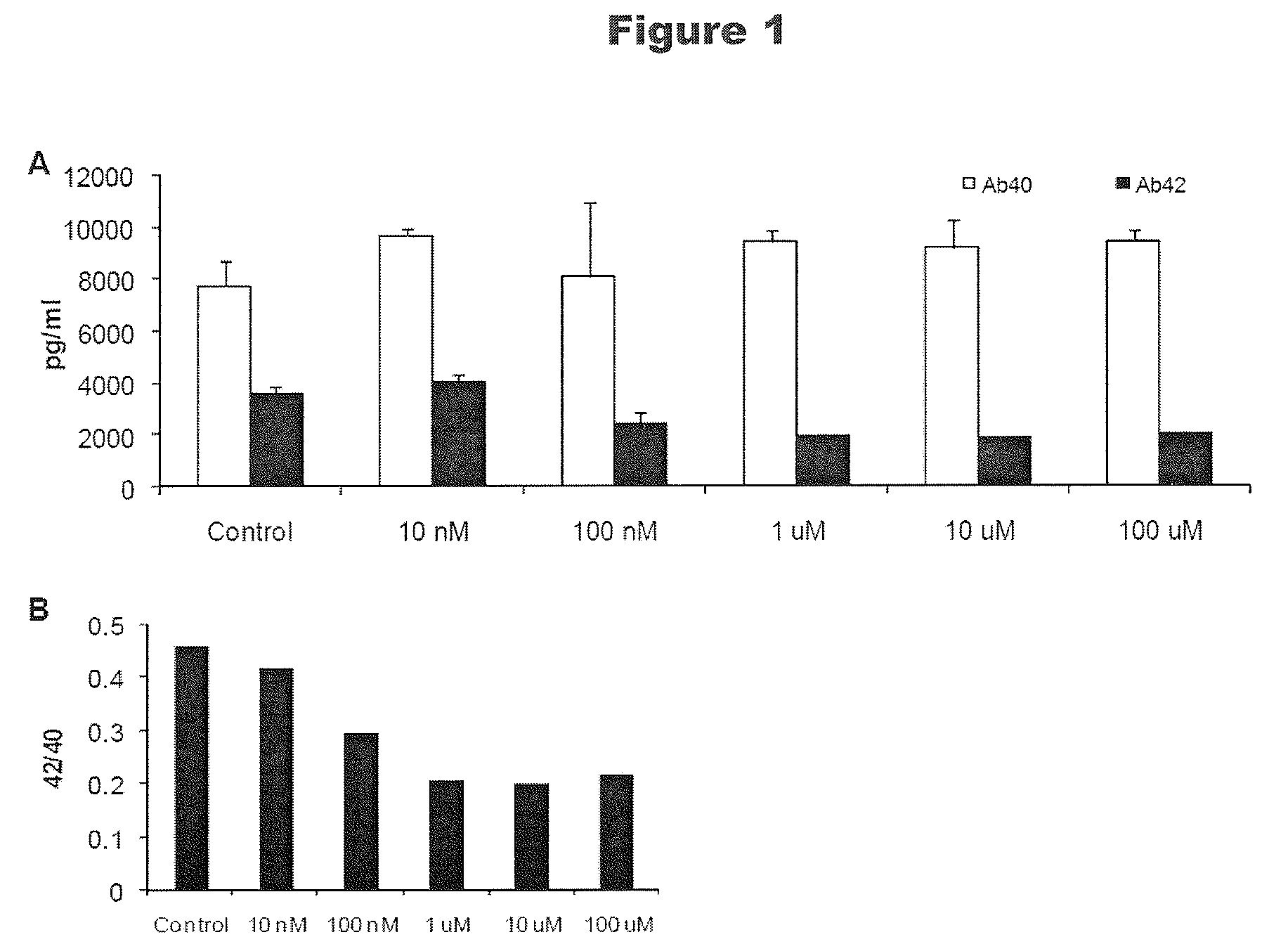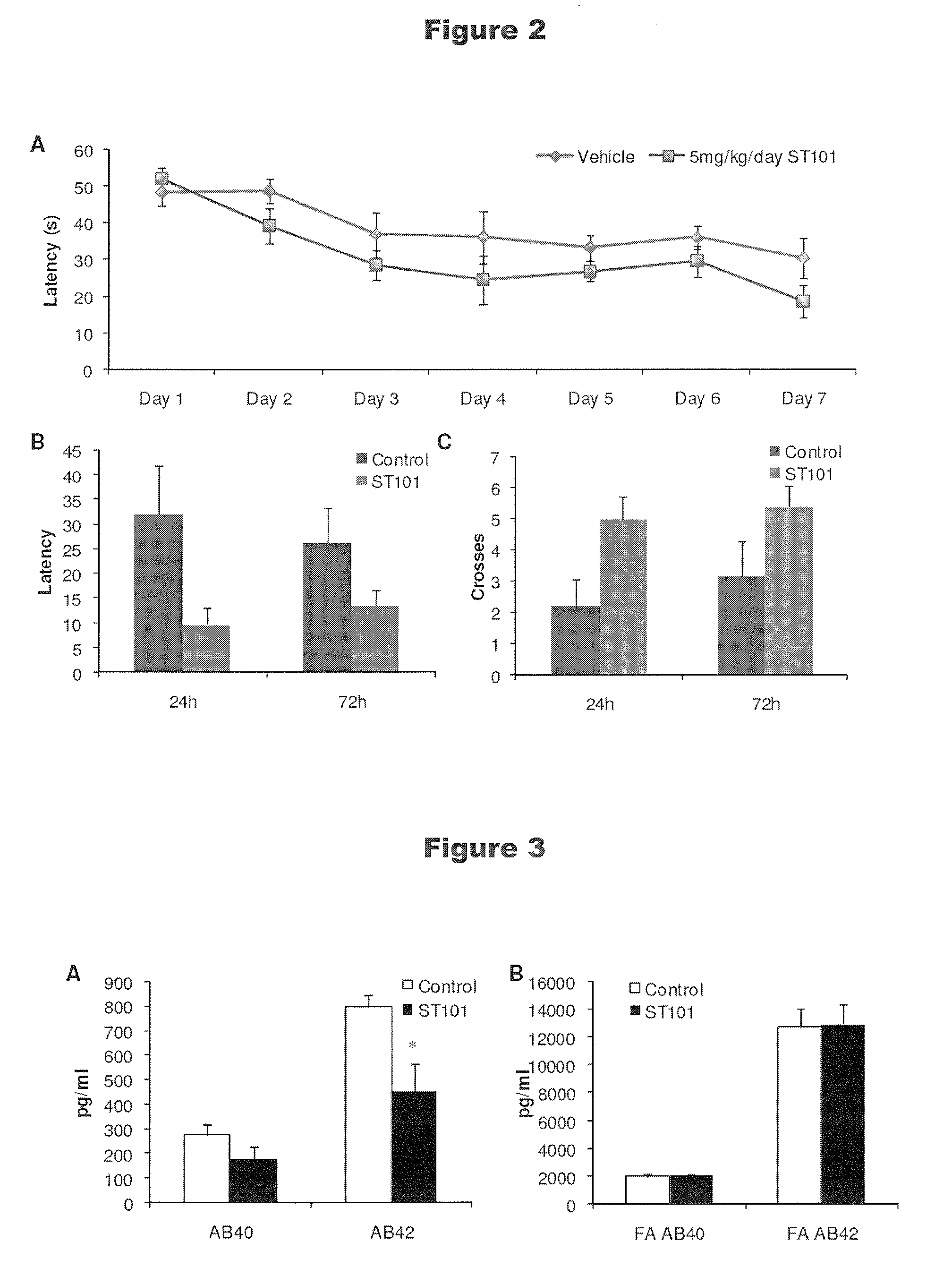Method of Decreasing Ubiquitylated Protein Levels
- Summary
- Abstract
- Description
- Claims
- Application Information
AI Technical Summary
Benefits of technology
Problems solved by technology
Method used
Image
Examples
example 1
Effect of ST101 on β Amyloid In Vitro in Neuro2a Cultured Cells
[0383]Neuro2a is a murine neuroblastoma cell line that is known to produce amyloid peptides Aβ1-40 and Aβ1-42 in amounts measurable by ELISA assays. These forms of Aβ have been correlated with the pathology in AD brain and Aβ1-42 in particular is postulated to have the ability to block a7 nicotinic receptors and to produce direct neurotoxic effects. Neuro2a cells were treated for 24 hours with ST101 added to the tissue culture medium. Tissue culture medium was collected and analyzed by ELISA for the presence of Aβ.
[0384]FIGS. 1A and 1B are bar graphs that depict the effect of the compound ST101 on Aβ production by Neuro2a cells. FIG. 1A is a bar graph that depicts the Aβ concentration in the cell culture medium as a function of ST101 concentration compared to control. FIG. 1B a bar graph that depicts the ratio of Aβ1-42 to Aβ1-40 as a function of ST101 concentration compared to control. As shown in FIGS. 1A and 1B, ST101...
example 2
Effect of ST101 in 3xTg-AD Mice in the Morrris Water Maze
[0385]Dr. Frank LaFerla's laboratory at the University of California, Irvine, has developed a transgenic mouse that contains 3 mutations relevant to Alzheimer's pathology (βAPPSwe, PS1M146V, and tauP301L) (Oddo et al., “Triple-transgenic model of AD with plaques and tangles: intracellular Aβ and synaptic dysfunction, Neuron 39(3):409-21 (2003)). These mutations shift APP cleavage from α- to β-secretase, increase production of Aβ1-42 and drive the accumulation of tau into paired-helical filaments. The 3xTg-AD animals develop essential features of AD in an age-dependent fashion, with deficits in memory-related behavioral function, plaque and tangle pathology and synaptic dysfunction, including deficits in long-term potentiation, an activity believed critical to memory (Oddo et al., 2003). Furthermore, plaque formation precedes tangle formation and so mimics the development of the AD in humans. The 3xTg-AD mouse represents one of...
example 3
Effect of ST101 on Aβ in Brain Tissue from 3xTg Mice-Ad
Biochemical Effects: ST101 and Amyloid Processing Pathways
[0392]At the end of the 2-month treatment period, 3xTg Mice were sacrificed and brain tissue was processed. In the first set of analyses, soluble Aβ1-40 and Aβ1-42, as well as insoluble Aβ (after formic acid extraction), were quantified by ELISA. Soluble Aβ represents protein that has been processed from full length APP and released. Insoluble Aβ represents fibrillar accumulates that are ultimately deposited in amyloid plaques.
[0393]FIGS. 3A and 3B are bar graphs that depict the effect of ST101 on Aβ in brain tissue from 3xTg mice-AD. FIG. 3A depicts the amounts of soluble Aβ1-40 and Aβ1-42 in brain tissue in mice treated with ST101, relative to control mice. FIG. 3B a bar graph that depicts the amounts of insoluble Aβ1-40 and Aβ1-42 (formic acid extraction) in mice treated with ST101, relative to control mice. One animal in the ST101 treated group in panel A was excluded...
PUM
 Login to View More
Login to View More Abstract
Description
Claims
Application Information
 Login to View More
Login to View More - R&D
- Intellectual Property
- Life Sciences
- Materials
- Tech Scout
- Unparalleled Data Quality
- Higher Quality Content
- 60% Fewer Hallucinations
Browse by: Latest US Patents, China's latest patents, Technical Efficacy Thesaurus, Application Domain, Technology Topic, Popular Technical Reports.
© 2025 PatSnap. All rights reserved.Legal|Privacy policy|Modern Slavery Act Transparency Statement|Sitemap|About US| Contact US: help@patsnap.com



